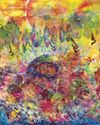
Virtual Reality is in some ways a simple concept: it can be reduced to an act of representation, symbolism, or language. Through technological means – be it a pencil or a VR headset – we can represent the past as we remember it and the future as we imagine it. Through language and imagery, we can maintain the human culture of sharing information by exteriorizing what previously was only known to us internally – creating outside of ourselves what was previously only accessible in the language of our minds. So in conceptual terms, even the first cave painting was a kind of Virtual Reality. Through that painting, humans could represent their thoughts and designs as an external, objective reality, chalked to the wall of a cave. In some ways, though, language was the first kind of Virtual Reality. With language we could make what was previously only inside our minds exist as something between us – just as now, while you are reading this article, a world of meaning exists between us, mediated by the words on the paper or screen.
Although language and VR are similar in conceptual terms, there is a crucial difference between mere language and actual VR technologies. Through the technology of Virtual Reality we are able to project our thoughts and our designs not as abstract conventions but in terms of the lived reality we inhabit. We can externalize our ideas in the format of reality. Language has the capability of allowing us to tell stories, but in Virtual Reality we have the capability of living those stories, not through the mind’s eye or the imagination, but through our everyday means of navigating the world via our senses. VR can immerse subjects in lively, dynamic, virtual worlds.
This story is from the August/September 2020 edition of Philosophy Now.
Start your 7-day Magzter GOLD free trial to access thousands of curated premium stories, and 9,000+ magazines and newspapers.
Already a subscriber ? Sign In
This story is from the August/September 2020 edition of Philosophy Now.
Start your 7-day Magzter GOLD free trial to access thousands of curated premium stories, and 9,000+ magazines and newspapers.
Already a subscriber? Sign In

Metaphors & Creativity
Ignacio Gonzalez-Martinez has a flash of inspiration about the role metaphors play in creative thought.

Medieval Islam & the Nature of God
Musa Mumtaz meditates on two maverick medieval Muslim metaphysicians.

Robert Stern
talks with AmirAli Maleki about philosophy in general, and Kant and Hegel in particular.

Volney (1757-1820)
John P. Irish travels the path of a revolutionary mind.

IT'S A WONDERFUL LIFE
Becky Lee Meadows considers questions of guilt, innocence, and despair in this classic Christmas movie.

"I refute it thus"
Raymond Tallis kicks immaterialism into touch.

Cave Girl Principles
Larry Chan takes us back to the dawn of thought.

A God of Limited Power
Philip Goff grasps hold of the problem of evil and comes up with a novel solution.

A Critique of Pure Atheism
Andrew Likoudis questions the basis of some popular atheist arguments.

Exploring Atheism
Amrit Pathak gives us a run-down of the foundations of modern atheism.